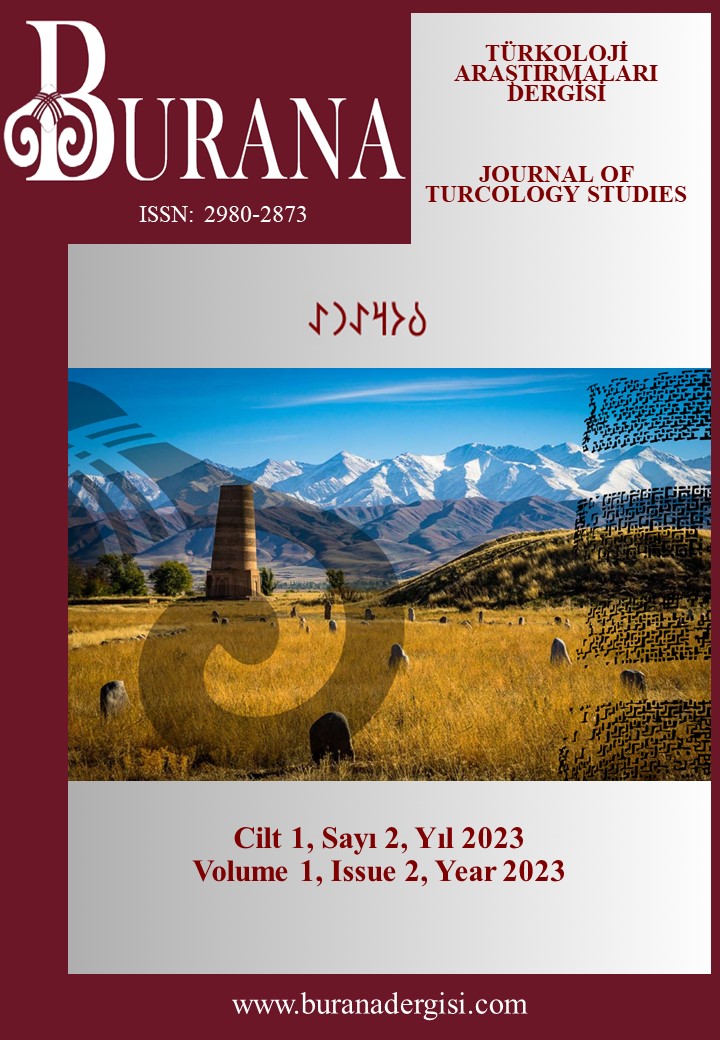Making a Verb from a Noun the Appearance of +lA- Suffix in Altai Turkish
DOI:
https://doi.org/10.5281/zenodo.10437795Keywords:
Morphology, Altaic Turkic, Construction of a Verb from a Noun with the Suffix, -lA SuffixAbstract
Altai Turks are one of the Turkic communities living in Southern Siberia. In terms of linguistic features, it has common aspects with the Southern Siberian Turkish dialects and is very similar to the Kyrgyz language. It is especially close to Kyrgyz in phonetic terms. Khakas Turkish, one of the South Siberian Turkic dialects, shows almost the same features as Kyrgyz Turkic in terms of secondary long vowels and rounding of vowels, which are not found in Tuva Turkish. The subject of this study, +lA-, is a suffix that has been used since Old Turkic and has preserved its existence until the current day. The suffix is used in many historical and contemporary Turkic languages. It has undergone some changes in terms of structure up to the present day. When we look at it in this context, the suffix -n-, -ş-, -t-, together with the verb-forming roof suffixes +lA-n-, +lA-ş-, +lA-t- are found in Altai Turkish as in many other dialects. The function of the suffix is to derive verbs from noun roots and stems and noun-derived words. It has been observed that in the Altaic language, which we will focus on in this study, the suffix +lA- derives verbs that express "doing, making" by coming to nouns. A detailed analysis reveals other functions of the suffix in Altaic Turkic. The different functions of the suffix +lA-, which attracts attention with this aspect, are emphasized in this study rather than its well-known function. The functions of the suffix will be classified in terms of the meaning it adds to the word. Examples were tried to be determined by scanning dictionaries in Altai Turkic. The appearance of the verb-forming feature of the suffix in Altai Turkic and its appearance in other dialects are mentioned in general.
References
Baltacı, A. (2019). Nitel araştırma süreci: Nitel bir araştırma nasıl yapılır? Ahi Evran Üniversitesi Sosyal Bilimler Enstitüsü Dergisi, 5(2), 368-388.
Baskakov, N. A. (1958). Altayskiy yazık. Nauka.
Baskakov, N. A. (2010). Dialekty altayskogo yazıka. Dybo A. V. (Ed.). Osnovy Turkskogo yazykoznaniya. dialekty Turkskix yazykov vnutri (s. 83-109). Izdatelskaya Firma «Vostoçnaya Literatura».
Dilek, F. G. (2022). Altay Türkçesi grameri. Türk Dil Kurumu.
Ercilasun, A. B. (2007). Türk lehçeleri grameri. Akçağ.
Naskali, E. G. ve Duranlı, M. (1999). Altayca-Türkçe sözlük. Türk Dil Kurumu.
Potapov, L. P. (1953). Oçerki po istorii altaytsev. Nauka.
Sağlam, B. (2014). Çağdaş Türk lehçelerinde şekil bilgisi ortaklıkları [Yüksek lisans tezi, Fırat Üniversitesi]. https://tez.yok.gov.tr/UlusalTezMerkezi/
Tavkul, U. (2003). Türk lehçelerinin sınıflandırılmasında bazı kriterler. Kırım Dergisi, 12(45), 23-32.
Tenişev, E. R. (1988). Sravnitelno-istoriçeskaya grammatika Turkskih yazıkov. Nauk.
Yürümez, R. (2020). Türk edebiyatında fakr-nâmeler ve Çağatay şairi Harâbâtî’nin fakr-nâmesi (İnceleme-çeviri yazı-tıpkıbasım). Paradigma.
Downloads
Published
How to Cite
Issue
Section
License
Copyright (c) 2023 BURANA - Journal of Turcology Studies

This work is licensed under a Creative Commons Attribution 4.0 International License.


